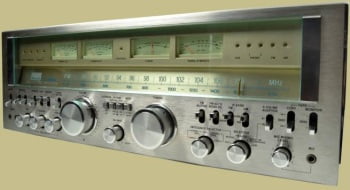
This is the giant Sansui G-22000. It listed at over $1400.00 and was only surpassed by it’s big brother the Sansui G-33000. The G-22000 was made from 1978 to 1980 and put out a whopping 240 watts per channel. Sansui engineers also utilized what they called the Diamond Differential DC circuit design. This allowed the audio signal to through the DC amplifier directly to the output without passing through a capacitor. Therefore, capacitors had no distorting effect on the audio signal.
The G-22000 also had a unique two piece design in which the power amp and the preamp are contained in separate units. This made it easier to move the preamp without having to move the heavier power amp and also helped reduce any interference the power amp might have on the preamp circuit. Together the unit weighs in at a massive 95 pounds!

The Sansui G-22000 also features:
- Linear Tracking FM Front end
- Five IC’s for IF
- A Group Delay Equalizer
- A Power Radio Detector
- An Adjacent Channel Filter
- Automatic Noise Filters
- Selectable Wide/Narrow IF Bandwidth for AM Channels
- Direct Readout Signal and Tuning Meters
- Stereo AM
- Selectable Phono Impedence
- Tone controls for Bass, Mid, and Treble
- Total Harmonic Distortion of 0.009%
Each stereo channel in the G-22000 have their own power supply utilizing two toroidal transformers and four capacitors.
A Sansui G-22000 in really good functioning condition can sell for over $6000 today. In fact, one G-22000 fully restored, with all the original boxes and literature, sold for $10,000 in 2023.


WHAT A GREAT CREATION THANKS TO THE JAPANESE SAMURAI SPIRIT
Will the g22000 work with out the power amp, or is power amp required to make the protection light turn off
Must have both sections to make the unit work correctly. More importantly, the multi-pin cord (on the back of the pre-amp) that connects the sections must be in good operable condition – or it won’t work.
There is no need for a preamp to work, but a power amplifier can’t work without a preamp.
These “volcanic” receivers were built to be the epitome of Japanese technology, design and manufacturing. They were big, heavy and complex…all the qualities that the Japanese worshiped and adored.
However, sonics of their power amps were not a strong point or was reliability as their inners were not up to the task of surviving the heat these amps produced. Their tuners were superb as were their beauty. They were big, heavy and expensive…as any show-case should be but they were not noted for their proportional sonics…except their tuners.
They are sought-after because of the aforementioned but they are sonicaly worth the thousands to restore them to above and beyond their former glories.
Very astute, well scripted synopsis of a sonic masterpiece. I bought mine in 78 and stored in for 25 yrsin a climate controlled storage unit. Had no problems with it after putting it in the den. Only regret is I should have brought the 33.